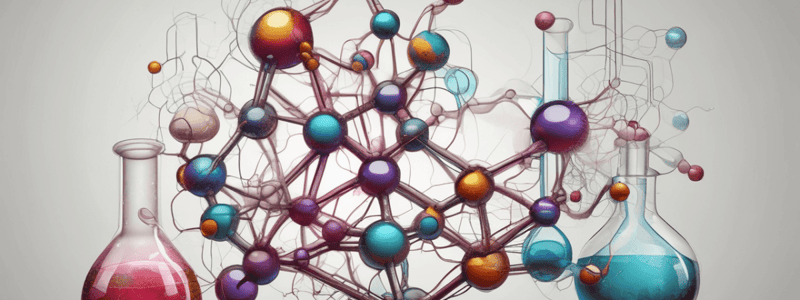Podcast
Questions and Answers
What is the primary focus of Chapter 10 in the provided organic chemistry textbook?
What is the primary focus of Chapter 10 in the provided organic chemistry textbook?
- Alkanes and Cycloalkanes
- Alcohols, Phenols, and Thiols (correct)
- Organic Halogen Compounds
- Carboxylic Acids and Their Derivatives
Which chapter discusses the synthesis of ethers?
Which chapter discusses the synthesis of ethers?
- Chapter 8: Stereoisomerism
- Chapter 10: Ethers and Epoxides (correct)
- Chapter 10: Alcohols, Phenols, and Thiols
- Chapter 9: Organic Halogen Compounds
What is the chapter number that covers the topic of Grignard reagents?
What is the chapter number that covers the topic of Grignard reagents?
- Chapter 11: Aldehydes and Ketones
- Chapter 9: Organic Halogen Compounds (correct)
- No specific chapter covers Grignard reagents
- Chapter 10: Alcohols, Phenols, and Thiols
What type of compounds are discussed in Chapter 7 of the textbook?
What type of compounds are discussed in Chapter 7 of the textbook?
In which chapter can you find the discussion of nucleotides and nucleic acids?
In which chapter can you find the discussion of nucleotides and nucleic acids?
What is the ISBN-10 of the textbook mentioned in the provided text?
What is the ISBN-10 of the textbook mentioned in the provided text?
Which of the following is used to illustrate the basic nature of the oxygen in ethers?
Which of the following is used to illustrate the basic nature of the oxygen in ethers?
What type of visualization skills are required for problems 5.28, 5.31, 5.36, 5.37, and 5.51?
What type of visualization skills are required for problems 5.28, 5.31, 5.36, 5.37, and 5.51?
What is used to illustrate the difference in base size between ethoxide and t-butoxide?
What is used to illustrate the difference in base size between ethoxide and t-butoxide?
Which chapter discusses the hydrogen-bonding properties of alcohols using an electrostatic potential map of 1-propanol?
Which chapter discusses the hydrogen-bonding properties of alcohols using an electrostatic potential map of 1-propanol?
What type of structures are used throughout Chapter 9?
What type of structures are used throughout Chapter 9?
Which of the following chapters discusses the synthesis of cyclic ethers, such as tetrahydrofuran and tetrahydropyran?
Which of the following chapters discusses the synthesis of cyclic ethers, such as tetrahydrofuran and tetrahydropyran?
What type of maps have been added to structures that accompany the titration curve of alanine?
What type of maps have been added to structures that accompany the titration curve of alanine?
Which figure illustrates the acid-base nature of intermolecular interactions in A-T and G-C base pairs?
Which figure illustrates the acid-base nature of intermolecular interactions in A-T and G-C base pairs?
What type of synthesis has been streamlined in Figure 17.7?
What type of synthesis has been streamlined in Figure 17.7?
Which problem requires students to extract acid-base information from an electrostatic potential map?
Which problem requires students to extract acid-base information from an electrostatic potential map?
What type of reaction is clarified in Figure 17.8?
What type of reaction is clarified in Figure 17.8?
Which section has been added to provide additional information on the Polymerase Chain Reaction (PCR)?
Which section has been added to provide additional information on the Polymerase Chain Reaction (PCR)?




